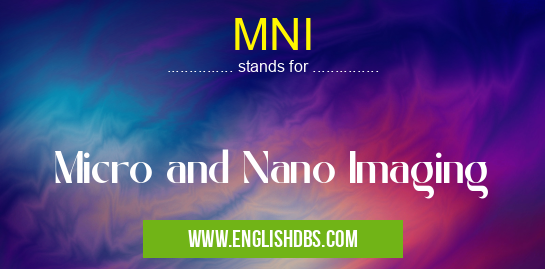What does MNI mean in PHOTOGRAPHY & IMAGING
MNI stands for Micro and Nano Imaging. It refers to a specialized field of imaging techniques that involve the visualization and analysis of structures and materials at the microscopic and nanoscopic levels. These techniques provide valuable insights into the properties, functionality, and behavior of materials on a very small scale.

MNI meaning in Photography & Imaging in Miscellaneous
MNI mostly used in an acronym Photography & Imaging in Category Miscellaneous that means Micro and Nano Imaging
Shorthand: MNI,
Full Form: Micro and Nano Imaging
For more information of "Micro and Nano Imaging", see the section below.
Types of MNI Techniques
MNI encompasses a wide range of imaging techniques, including:
- Atomic Force Microscopy (AFM): Provides three-dimensional surface topography and mechanical properties of materials.
- Confocal Microscopy (CM): Generates high-resolution images of biological specimens and thin materials.
- Electron Microscopy (EM): Uses electron beams to create detailed images of materials at the atomic level.
- Magnetic Resonance Imaging (MRI): Visualizes the内部structures of materials using magnetic fields and radio waves.
- Optical Microscopy (OM): Uses visible light to examine materials and biological specimens.
- Scanning Probe Microscopy (SPM): Includes techniques like AFM and Scanning Tunneling Microscopy (STM), which generate surface topography and electronic properties of materials.
Applications of MNI
MNI techniques find applications in various fields, including:
- Materials Science: Characterizing the structure, properties, and defects in materials.
- Biological Sciences: Imaging cellular structures, organelles, and molecular interactions.
- Medical Diagnostics: Visualizing tissues, diagnosing diseases, and guiding surgeries.
- Pharmaceutical Research: Studying the interactions of drugs with biological systems.
- Nanotechnology: Developing and characterizing nanoengineered materials and devices.
Benefits of MNI
- High Resolution: MNI techniques provide unprecedented resolution, enabling the visualization of fine details at the micro and nano scales.
- Non-Destructive: Most MNI methods are non-destructive, allowing the analysis of samples without damaging them.
- Quantitative Analysis: MNI can provide quantitative information about the size, shape, and properties of materials.
- Wide Applications: MNI techniques have applications across a diverse range of disciplines.
Essential Questions and Answers on Micro and Nano Imaging in "MISCELLANEOUS»PHOTOGRAPHY"
What is Micro and Nano Imaging (MNI)?
MNI is an advanced imaging technique that utilizes specialized equipment and methods to capture high-resolution images of extremely small structures and materials, ranging from micrometers (µm) to nanometers (nm) in size.
What are the applications of MNI?
MNI has wide-ranging applications in various scientific fields, including materials science, biology, medicine, and engineering. It enables researchers to:
- Study the structure and properties of materials at the micro- and nano-scale.
- Investigate biological processes and cellular components in detail.
- Develop advanced medical imaging techniques for diagnosis and treatment.
- Engineer new materials with enhanced properties and functionalities.
What are the different types of MNI techniques?
There are various MNI techniques, including:
- Scanning electron microscopy (SEM)
- Transmission electron microscopy (TEM)
- Atomic force microscopy (AFM)
- Scanning probe microscopy (SPM)
- Super-resolution microscopy Each technique offers unique capabilities for imaging different aspects of a sample.
How does MNI work?
MNI techniques use different principles to generate high-resolution images. For example, SEM scans a sample with a focused electron beam, while TEM passes electrons through a thin sample. AFM and SPM use a sharp probe to scan the sample's surface, providing information about its topography.
What are the advantages of using MNI?
MNI offers several advantages:
- High resolution: it can capture images with resolutions down to a few nanometers.
- Non-destructive: many MNI techniques do not damage the sample, allowing for repeated imaging.
- Versatile: MNI can be used to study a wide range of materials and biological samples.
- Wide availability: MNI equipment is widely accessible in research institutions and commercial facilities.
Final Words: MNI is a rapidly evolving field that continues to advance our understanding of materials and biological systems. By providing high-resolution images and quantitative data, MNI techniques empower researchers and scientists to explore and manipulate materials at the smallest scales, unlocking new possibilities for innovation and discovery.
